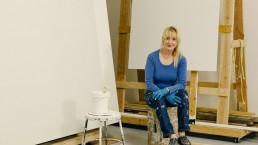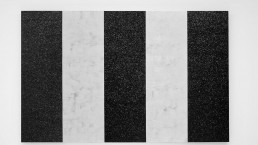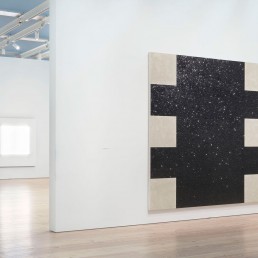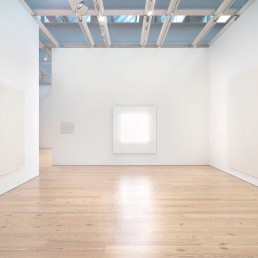
Artland’s Lost (and Found) Artist Series focuses on artists who were originally omitted from the mainstream art canon or largely invisible for most of their career. The second artist in this series is Mary Corse.
Every since she was an art student in the 1960s, Mary Corse, who is now 74 years old, has been fascinated by imbuing and illuminating art with light. Corse was one of the few female artists associated with the West Coast Light and Space Movement of the 1960s and 1970s. Like her contemporaries, she was enthralled by the idea that light in itself could function as a subject and material of art. Corse, along with several other artists like Larry Bell and John McCracken, helped establish a branch of West Coast minimalism. They often painted shiny surfaces with the aim to investigate perception and light. Many of her male peers were widely recognised, yet Corse remained largely unrecognised. Several reasons for this could be that she was really always doing her own thing, never quite belonging to any one art movement in particular though she was associated with various ones. The fact that she was a female artist in the ’60s and ’70s who was more interested in just getting on with her work than in trying to make connections or painting for the market would also have had an influence on how her career developed. And even though her work has been in the permanent collections of several major institutions like the Guggenheim, LACMA, and the Menil Collection for many years, ironically, it’s as though this ‘Queen of Light’ has always remained just beyond the reach of the spotlight.
Corse was initially trained as an abstract painter and started out making abstract expressionist paintings inspired by Hans Hofmann and Josef Albers. However, as early as 1964, when she was just 19, she abandoned this in order to experiment with a series of all-white canvases on which she made subtle grooves made from different layers of paint. It was the vibration of light that really interested her. She also started making electric light boxes, even immersing herself in quantum physics for this project. What makes her art so mesmerising, and has also often made it difficult for it to be properly recognised, is the fact that Corse always wanted light to be in the painting, thereby making her work difficult to reproduce. Just seeing a photograph doesn’t do the artwork justice, as Corse’s work could simply look like a white square on a photograph. In person, however, every movement you make and every different angle from which you look at the piece gives a totally different experience. The experience of a Mary Corse artwork then becomes a very personal, almost meditative experience which invites one to reflect on the fleeting nature of things. “We appear and disappear,” says Corse in relation to her artistic practice. In a video by the Whitney Museum of American Art, Corse talks about her journey using light in her art:
“Early on I had made lightboxes, light pieces, light paintings, but then they seemed to deal too much with an objective reality, and outside world. And I wanted to have what I was working on or what I was doing be more of a perceptual, more of an inner experience. But I still wanted to put the light in the paintings because the light was one of the essential parts. So I went around searching for how to do that and found these spheres right in the road; they actually refract the light, they don’t reflect. It’s a one-two-three instead of one-two-reflect. It makes a triangle between the viewer, the surface, and the light. So as you move, or as the light changes, the painting changes.”
Those spheres in the road she speaks of are made up of special paint that lines roads and highways and remains illuminated at night. Fascinated, Corse started using this material in her paintings and never looked back.



Recognition for Corse started accumulating in 2011, when several important figures discovered her at an exhibition at the Museum of Contemporary Art San Diego. Jessica Morgan, the director of Dia: Beacon, which recently acquired four Mary Corse works, saw her works there in 2011, and says “it is kind of confounding that we were not aware of her work.” At that same exhibition, Kim Conaty, the Steven and Ann Ames curator of drawings and prints at the Whitney was struck by Corse’s pieces and realised how important she was. “I couldn’t believe I hadn’t really studied her or been aware of her practice,” she said. Also in 2011, Lehmann Maupin began working with her. David Maupin, co-founder, says the value of Corse’s work has increased with about 50% over the past 8 years, with works on the private market currently selling for between $100.000 and $500.000. In 2016, Kayne Griffin gallery started representing Corse as well, and Lisson Gallery began representing the artist in 2017. With recognition and representation slowly building over the years, it seems that 2018 marked the year in which recognition really manifested itself for Corse, with two major New York exhibitions (at the Whitney and at Dia: Beacon) and several international gallery shows (including the artist’s first major solo exhibition in the UK at London’s Lisson Gallery). She also began a relationship with New York’s Pace Gallery in 2018, which is now representing her in the US and Asia.
With all the hustle and bustle around her in the art world now, Mary Corse remains stoic and levelheaded about what painting means to her. “It’s my sanity,” she said in a 2017 interview with Carolina A. Miranda for the Los Angeles Times. “As soon as the paint brush is in my hand it’s another conversation. It’s the infinite rather than the finite.”
Dia: Beacon is showing Corse’s work through 2021, while Pace Gallery will be representing her in Hong Kong, Beijing and Seoul from March 2019, and exhibiting her in New York in 2020 – plenty of opportunities to catch the artist’s mesmerising light works in person.
Gallery
Dia: Beacon, 3 Beekman Street, Beacon, New York 12508
Exhibition on
Through 2021
Website
Diaart.com
PACE Hong Kong, 12/F, H Queen’s, 80 Queen’s Road Central, Hong Kong
Exhibition on
March 2019
Website
Pacegallery.com